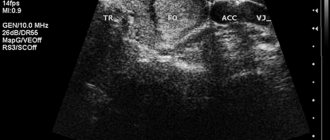Tumor size: T = Tumor, tumor
Doctors use the letter T in combination with numbers and letters to indicate the presence or absence of a primary tumor, its size, and the number of affected tissues and organs:
Tx
— there is insufficient data to evaluate the tumor.
T0
- there are no signs of a primary tumor.
Tis (DLCIS)
- Ductal cancer cells found in the ducts of the breast.
Tis (LCIS)
- Lobular cancer cells found in the lobules of the breast.
Tis (Paget)
- Paget's cancer (nipple) without signs of a tumor.
If a tumor is present, the assessment is based on its size. T1mic
- tumor up to 0.1 cm in size
T1a
- tumor in size from 0.1 cm to 0.5 cm
T1b
- tumor in size from 0.5 to 1 cm
T1c
- tumor in size from 1 to 2 cm
T2
- tumor from 2 to 5 cm.
T3
- tumor larger than 5 cm.
T4
- tumor of any size that has spread to the skin or chest wall:
T4a
- tumor has grown into the chest wall (ribs, intercostal muscles, serratus anterior muscle).
T4b
- Swelling, ulcers or daughter tumors in the skin of the breast, including the "lemon peel" symptom. The "lemon peel" symptom is thickening and swelling of the skin, with the sweat glands being very prominent.
T4c
- all symptoms listed in T4a and T4b.
T4d
- inflammatory or edematous cancer: thickening of the skin with dense edges.
The letter T without letter and numeric specifications does not contain any information.
conclusions
You should immediately contact the oncology center if you find the following signs of the disease:
- enlargement of lymph nodes and mammary glands;
- change in color of the mammary glands;
- release of liquid from them;
- compaction in the area of the mammary glands and their canals.
With such symptoms, self-medication is unacceptable. Please know that thanks to new equipment there is a huge chance of getting rid of such an oncological disease as breast cancer, stage 2a. The prognosis for recovery is very high if the malignant tumor is removed in a timely manner.
Lymph nodes: N = Nodes, lymph nodes
Lymph nodes (lymph nodes) act as filters, helping to fight infection and remove harmful substances from the body. There are hundreds of them in the human body.
It is very important to know whether the cancer has affected the lymph nodes - this significantly affects the treatment plan and tactics.
To describe the number and type of affected lymph nodes, doctors use the letter “N” in combination with numbers and letters:
NX
means that the status of the lymph nodes cannot be assessed.
N0
- lymph nodes are not affected.
N1
- metastases are present in the displaced axillary lymph nodes on the affected side.
- N1mic
- micrometastases larger than 0.2, but less than 2 mm in size are present in the displaced axillary lymph nodes on the affected side.
N2
- metastases in the axillary lymph nodes on the affected side, fused together or fixed.
Or metastases in the intrathoracic lymph nodes, while the axillary lymph nodes are not affected: - N2a
- metastases in the axillary lymph nodes on the affected side, fused together or fixed.
- N2b
- metastases in the intrathoracic lymph nodes, while the axillary lymph nodes are not affected.
N3
- metastases in the subclavian lymph nodes on the affected side, or in the intrathoracic + axillary lymph nodes, or metastases in the supraclavicular lymph nodes on the affected side (regardless of the condition of the axillary and intrathoracic lymph nodes).
- N3a
- metastases in the subclavian lymph nodes on the affected side.
— N3b
— metastases in intrathoracic + axillary lymph nodes.
— N3c
— metastases in the supraclavicular lymph nodes on the affected side.
The letter “N” without alphabetic and digital designations does not contain information.
Breast cancer, metastases: prognosis
With timely diagnosis of the disease, the pathology can be completely cured. In advanced stages of the disease with a large number of metastases, modern medical methods can extend the patient’s life to several decades. At the same time, the quality of life remains at a high level.
The main thing is not to postpone your visit to the clinic if any feeling of discomfort appears. The Yusupov Hospital uses the latest treatment methods, and every day scientists develop effective ways to combat cancer. Diagnoses that previously sounded like a death sentence can now be treated with high efficiency.
A properly selected treatment program by oncologists can cure a huge number of patients.
Call the Yusupov Hospital by phone or make an appointment using the appointment form on the website. The center's coordinator will answer all your questions.
Metastasis: M = Metastasis
Each healthy cell in the body has its own specific place in a tissue or organ. Cancer cells can travel throughout the body, creating tumors in different parts of the body.
The tumor created by the division of these cells is called a metastasis.
To describe the presence or absence of metastases, the designation “M” is used in combination with numbers or letters:
MX
means it is impossible to estimate how far the cancer has spread.
M0
- no distant metastases.
M1
- there are distant metastases.
"M1" means you have stage 4 breast cancer. — Mpul
metastases to the lung,
— Moss
metastases to the bone,
— Mhep
metastases to the liver,
— Mple
metastases to the pleura,
— Mper
metastases to the peritoneum,
— Mmar
metastases to the bone marrow,
— Mbra
metastases to the brain,
— Mski
metastases to the skin,
— Madr
metastases in the adrenal glands,
- Mlym
metastases in the lymph nodes,
- Moth
metastases in other organs.
Without clarifying letters and numbers, “M” does not contain information about the course of the disease.
Diagnosis of the presence of metastases
It is sometimes very difficult to conduct a thorough diagnosis of relapse, since often (especially at an early stage of development) the tumor can be so tiny that it is difficult to detect.
Modern research that is used for examination:
- using ultrasound diagnostics, pathological changes in internal organs can be observed;
- Magnetic resonance imaging of the brain and spinal cord will give accurate indications of the presence of a tumor process;
- positron emission tomography will allow you to study in detail the internal organs and brain; the technique has the highest reliability in detecting metastases;
- X-rays of the chest (lungs) and bones will help identify foci of metastases;
- a mammogram is carried out to examine the breast (if it has not been removed in fragments) in which there was a tumor; in addition, there are risks of damage to the second breast, so it is also examined;
- biopsy of tissues that require additional research;
- bronchoscopy – study of the lungs.
For a high-quality and complete examination, additional laboratory tests (blood from a vein) are recommended to identify breast cancer-specific markers (CEA, CA15-3, CA27-29).
In addition, laboratory tests include bilirubin testing. Thus, a change in its level indicates liver problems, which may indicate the formation of metastases.
A general blood test fully reflects the functioning of the hematopoietic organs. A change in formula may signal that careful research is needed.
рN: Affected regional lymph nodes (рN)
To determine pH, it is necessary to remove axillary lymph nodes. A biopsy (cell collection) of the sentinel (sentinel) lymph nodes may be required.
The sentinel lymph nodes are the first ones on the path of lymph outflow from the primary focus of a cancerous tumor.
Regional - lymph nodes of a certain area (axillary, inguinal, breast, etc.).
рNx
- means that there is no data on the affected regional lymph nodes (no lymph nodes have been found, or they have not yet been removed).
pN0
- no signs of metastasis of regional lymph nodes were found during the study.
No additional methods were used to detect cancer cells. pN0 (I-)
- there are no signs of metastasis in regional lymph nodes according to histological and IHC (immunohistochemical) studies.
pN0(I+)
- cancer cells measuring 0.2 mm or less were found in regional lymph nodes (according to histological and IHC studies).
рN1: — рN1mic
— micrometastases greater than 0.2, but less than 2 mm.
— pN1a
— metastases were found in one to three axillary lymph nodes, one of which is larger than 2 mm.
— рN1b
— metastases in the lymph nodes of the mammary gland in combination with micro- or macrometastases identified by biopsy.
- pN1c
- metastases in one to three axillary lymph nodes in the internal lymph nodes of the mammary gland in combination with micro- or macrometastases identified by biopsy.
рN2: — рN2a
— metastases in four to nine axillary lymph nodes measuring 2 mm or larger.
— рN2b
— the internal lymph nodes of the mammary gland are affected.
There are no metastases in the axillary lymph nodes. pH3: - рN3a
- metastases measuring 2 mm or more in ten or more axillary lymph nodes.
Or metastases in the subclavian lymph nodes. - рN4b
- metastases in the internal lymph nodes of the mammary gland + metastases in one or more axillary lymph nodes.
Or metastases of three or more axillary lymph nodes + micro- or macrometastases of sentinel lymph nodes. — рN3c
— metastases in supraclavicular lymph nodes.
Modern treatment of metastases
Many of us know that at this stage in medicine there is no effective and good cure for metastases. However, we should not despair, as there are other methods that may not be as effective as we would like, but, nevertheless, give hope and a chance at life.
Popular treatments for metastases and metastasis:
- surgical removal of the lesion;
- chemotherapy – aimed at inhibiting or stopping metastasis;
- radiation therapy;
- hormonal treatment;
- medicinal sedatives and analgesics;
- Alternative medicine.
Surgical removal, depending on the size of the tumor and its location, is performed using several methods: resection of a part of an organ or removal of the entire organ (if possible). Before instrumental intervention, the patient is given chemotherapy to reduce tumor nodes.
Chemotherapy is a long-term and highly effective treatment. Sometimes it can be used to destroy not only the primary malignant focus, but also metastases, including distant ones. Chemotherapy has many side effects, which sometimes cause a complex reaction, so treatment is carried out only in a hospital. After this type of therapy has had a positive effect and the tumor has gone away, it is recommended to carry out maintenance treatment according to a certain scheme (in the remission stage).
Radiation therapy is used in cases where there are metastases in places that are difficult for a surgeon to reach with a knife. This type of treatment is considered more gentle than chemotherapy and sometimes shows good results in the fight against the tumor.
Hormonal therapy is carried out in cases where the tumor is sensitive to estrogens and progesterones.
Drug treatment of breast metastases is carried out in parallel with other methods described above. Basically, the effect of medications is aimed at combating those symptoms that caused secondary tumors. Painkillers are also recommended - these are strong analgesics and psychotropic drugs, which are issued strictly under the “red seal” in a medical institution. As a rule, such treatment is prescribed to alleviate a general condition in which severe and unbearable pain is noted.
Ethnoscience. Despite modern highly effective treatment, many patients for some reason continue to believe dubious persons who promise to get rid of a malignant scourge in a short period of time and at the same time give a 100% guarantee of successful treatment. This point can be left without comment, just adding one thing - in medical practice these are not isolated cases and all of them lead to the fact that patients still come to the clinic at that stage of the development of metastases when nothing can be done.
Differentiation: G = Grade, grade
Differentiation of the tumor is necessary so that the doctor can predict how quickly it will develop and how well it will respond to treatment. A tumor whose cells are very similar to healthy ones, grows slowly and responds well to treatment. This tumor is called well-differentiated breast cancer. Cells that do not look healthy at all grow quickly, but are treated poorly. Such tumors are called undifferentiated breast cancer. To determine differentiation, the attending physician submits part of the tumor tissue for laboratory testing. Pathological examination determines how much cancer cells differ from normal cells. The greater the difference, the faster the cancer is expected to spread.
GX
— the degree of difference cannot be determined (possibly due to insufficient material).
G1
- Cancer cells look similar to healthy cells.
These tumors tend to grow slowly. This is a well-differentiated breast cancer. G2
- cancer cells are slightly different from healthy cells.
This is a moderately differentiated tumor. G3
- cancer cells are very different from healthy cells.
Such a tumor is called poorly differentiated. G4
- cancer cells are completely different from healthy ones. This is an undifferentiated tumor. Most likely it will develop very quickly
Instead of using the letter "G" in the diagnosis, the doctor may describe the degree of differentiation (different from normal) tumor cells in words.
Breast cancer is staged based on T, N, and M information.
In stages I–IV, clarifying letter designations are additionally used.
It is important to understand that the same stage designation does not mean the same situation.
For example, stage IIA may be coded as T0N1M0, T1N1M0, and T2N0M0. That is, for different tumor sizes and different numbers of affected lymph nodes, one stage can be indicated.
Talking to your doctor
It is extremely important that you talk to your oncologist and healthcare provider about any symptoms you are experiencing. Some of these symptoms, such as pain, are undertreated in people with metastatic cancer. This is not because doctors cannot treat the symptoms, but because they simply do not know that the person is coping with them.
Because all the talk is about people with cancer being "brave" or "strong," you may be hesitant to share symptoms that may make you feel "scared" or "weak." Still, facing metastatic cancer is scary, and being able to share your concerns is a sign of strength, not weakness. There's a lot you can do to ease most symptoms of metastatic breast cancer, but the only way your oncologist will know how you feel is if you're "brave enough" to speak up.
Additionally, sharing your symptoms, even though they may seem minor, can help your oncologist better recognize the extent of your disease, anticipate possible complications, and suggest the best possible treatments for your disease.
List of sources used:
- Irvin W, Muss HB, Mayer DK. Symptom management in metastatic breast cancer. Oncologist. 2011
- American Cancer Society. If you have liver cancer. Updated April 1, 2019
- Patel K, West HJ. Febrile neutropenia. JAMA Oncol. 2017
- American Cancer Society. Managing symptoms of advanced cancer. Updated December 16, 2016
Treatment of stage II breast cancer
At stage II, breast carcinoma reaches a diameter of 5 cm or more and/or spreads to the axillary lymph nodes on the side of the primary tumor.
The main type of treatment is still surgery; in some cases, organ-conserving surgery can be performed followed by a course of radiation therapy.
Treatment with anticancer drugs can be carried out both before and after surgery. Chemotherapy drugs are used, for hormone-positive cancer - hormonal drugs, for HER2-positive cancer - targeted drugs.










